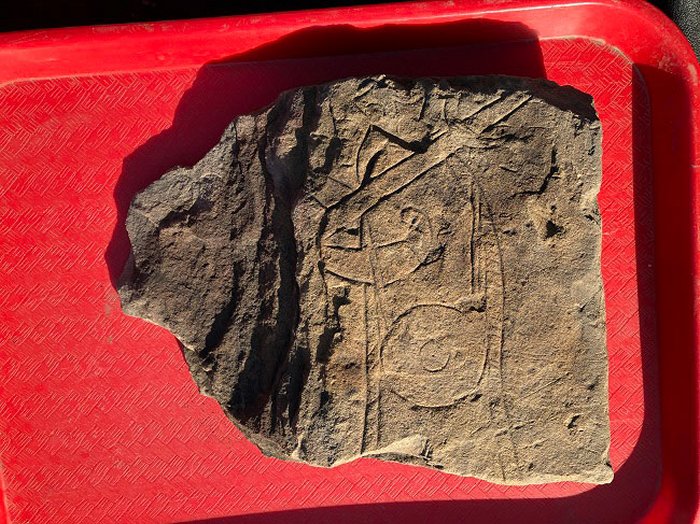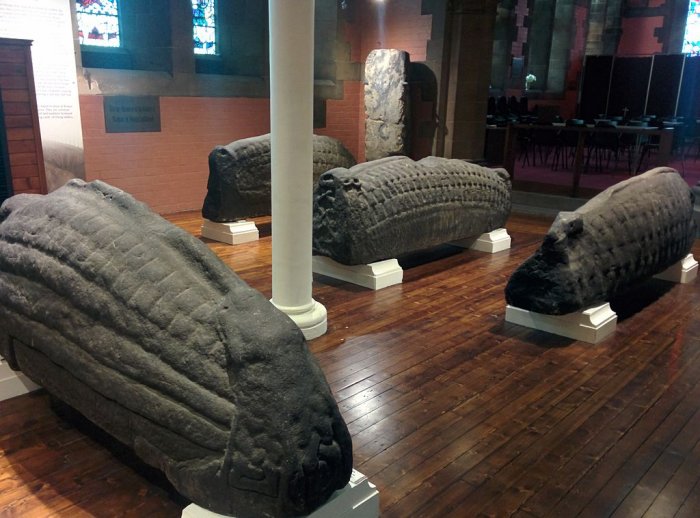Jan Bartek – AncientPages.com – Scientists made a remarkable new find during an archaeological dig at Govan Old Churchyard in Glasgow, Scotland. Led by y the University of Glasgow’s Professor Stephen Driscoll and Clyde Archaeology, the research team uncovered an early Medieval carved stone of a warrior figure.
Scientists say the stone is quite unlike any others discovered at this ancient site which is celebrated for its richness in its Viking-Age sculpture.

The ‘Govan Warrior’ discovered at Govan Old churchyard on 16th September 2023. Credit: Govan Heritage Trust
The stone portrays a man side-on carrying a round shield and a shaft over their shoulder. The man is probably carrying either a sword or a spear and can be described as a warrior. While much of the warrior’s face has been damaged since it was carved over a thousand years ago, remarkable details suggest a flowing ponytail and a sharply pointed beard.
Govan Old is the home of the Govan Stones Museum, which contains one of Europe’s finest collections of early medieval and Viking-age sculpture.
A collection of over 30 sculptures produced by the Viking-age Kingdom of Strathclyde, a lost kingdom of Old Welsh-speaking Britons who dominated the Clyde valley from the 5th – 11th centuries AD.
The new find, currently nicknamed the ‘Govan Warrior’, is exceptional for its quality even amongst the superb existing collection, which includes the unique Govan Sarcophagus, the Govan Cross and five hogback gravestones, a Scandinavian-style funerary monument that dates to the 9th/10th centuries.
The Govan Warrior is unique within the existing collection due to its stylistic characteristics, which have drawn parallels with Pictish art and carvings from the Isle of Man.
Unlike the other stones in the Govan collection, whose chunky style of carving is so distinctive that it has been described as a school of carving in its own right (the ‘Govan School’), the Govan Warrior is lightly incised, which may bring parallels with famous Pictish stones like the Rhynie Man from Aberdeenshire.
“It’s a style that makes us think both about the Pictish world and also about the Isle of Man and it’s interesting that we are halfway between these two places. Govan is the ideal place for these two artistic traditions or styles to come together.

Govan carved Viking Hogsback stones. Image credit: – CC BY-SA 3.0
“This is probably the most important find that I’ve made in my 30 years of working at Govan Old. The new stone is very exciting because it takes the collection to a different cultural place as it does not look like the heavier and chunkier ‘Govan School’ style.
The new stone is much more delicate in its execution using finer shallow incisions,” Professor Stephen Driscoll said in a press statement.
See also: More Archaeology News
As previously discussed on Ancient Pages, “carved in the 9th – 11th centuries, the Govan Stones probably commemorate the power of those who ruled the native Briton Kingdom of Strathclyde, the lost kingdom of the northern Britons.
The total number of stones was forty-five, but many were lost.”
Written by Jan Bartek – AncientPages.com Staff Writer





